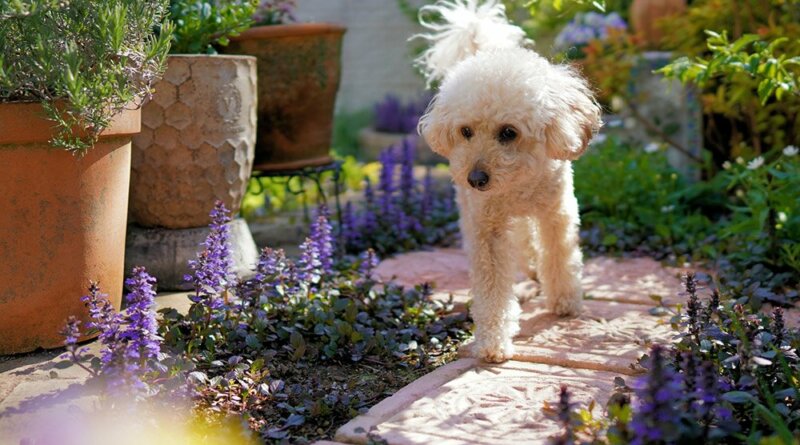How to Keep Dogs Out of Gardens
We’re not the only ones who notice when gardens start to grow—dogs are also well aware of blooming flowers, vegetables and herbs. Like enthusiastic but inept gardeners, they’ll sniff the new growth, walk all over it, paw at it or even dig it up. Not only is it frustrating to deal with the damage, it can also be dangerous for the dog. Here are a few ways to make it easier to protect both your garden and your four-legged helper.
Dogs rarely treat gardens with the tender care they require, and—more significantly—some flowers and other plants are toxic to them. Keeping your dog (or dogs) from getting into your garden each spring and summer can be a challenge, but fortunately, it’s one that can be met by approaching it from several angles. Following are some strategies that will discourage your resident canine “gardener.”
Use barriers. Perhaps it sounds too obvious, but a physical barrier can prevent dogs from having access to areas where they’re likely to cause damage. Many people object to putting up chicken wire, a fence or otherwise blocking off the garden, and that’s a shame. There’s no easier or more effective way to solve the problem, at least temporarily, while you work on training your dog to stay out of the area. Managing the situation and preventing a problem is a great idea, but all too often, people feel like it’s a cop-out. It’s not! Barriers keep everyone safe and protect what’s valuable—our dogs, first and foremost, but also, our gardens.
Supervise the dog. Left on their own to amuse themselves, dogs will often find gardens very tempting; they’re far more likely to dig or pull out plants than dogs whose people are outside with them. If you’re out there, you can engage your dog in activities such as fetch, tug or chase, all of which are likely to be more appealing than the garden. Additionally, if you’re outside with your dog and she does head for the garden, you can interrupt that behavior and redirect her to another activity—ideally, before damage is done. What kind of activities? I’m glad you asked.
Offer other activities. Many dogs find gardens to be great fun, but if they’re given something even more fun to do, the garden will be safer. As mentioned, playing with your dog is one way to keep her engaged in something other than digging and removing plants, and there are other options as well. Offering a vet-approved chew or a puzzle toy such as a stuffed Kong are great options because dogs tend to love them. Having all kinds of toys available increases the odds that your dog will focus on one of them rather than on your vegetables, herbs or flowers.
GET THE BARK NEWSLETTER IN YOUR INBOX!
Sign up and get the answers to your questions.
Create a dedicated digging area. It’s natural for dogs to dig, which makes it challenging to teach them not to do it. However, a far more manageable task is to teach them where to dig. So, instead of a flat out “no” to digging, the message is “dig here, not there.” To make it most tempting to your dog, choose an area with good soil, then make it the best spot in the yard by burying treasures for her to uncover. Stuffed Kongs, bones, chew toys and treats will make it even more appealing to her.
Garden in containers or raised beds. It’s easier for dogs to understand what’s off-limits if the distinction between areas where she’s allowed and areas she should avoid are clearly delineated. If your garden plants are in pots or in raised beds with borders and there are paths around them, it’s easier to redirect your dog to other areas of the yard, and easier for her to understand that those plants and that area are not for her.
Garden when your dog isn’t around. Many dogs copy our behavior, so if they see us dig, pull weeds or thin new seedlings, they may join in. Even if they don’t imitate us precisely, they are likely to investigate any area they see us in. This “social facilitation” means that their interest is sparked by our presence. Once they’re in the garden, they almost can’t help themselves. The next thing you know, they’re destroying all our hard work. No, I’m not saying you need to sneak around to work in your garden—just choose a time when your dog is otherwise occupied, preferably inside the house.
Teach your dog cues to communicate what she should do. Your dog isn’t digging in the garden or pulling up plants to make you crazy, to rebel or to cause problems. She’s doing it because it’s interesting and she doesn’t know that the behavior is unwelcome. To let her know her help isn’t needed, it’s useful to teach the cue “Leave it,” which means she may not approach an object or take it in her mouth. Another important cue is “Drop it,” which communicates that she should release the item in her mouth. That way, if she does pull up a plant, you may still be able to save and replant it (depending on its condition at that point!).
More importantly, if the plant’s toxic but the dog drops it, she’s exposed to less of the toxin. Preventing her from swallowing a dangerous plants is essential, and “Drop it” is a great way to do that. Be sure to reinforce your dog with great treats, toys, play or something to chew as a reward for responding correctly to these cues.
With a variety of tactics, we can keep our dogs and our gardens safe from each other!




